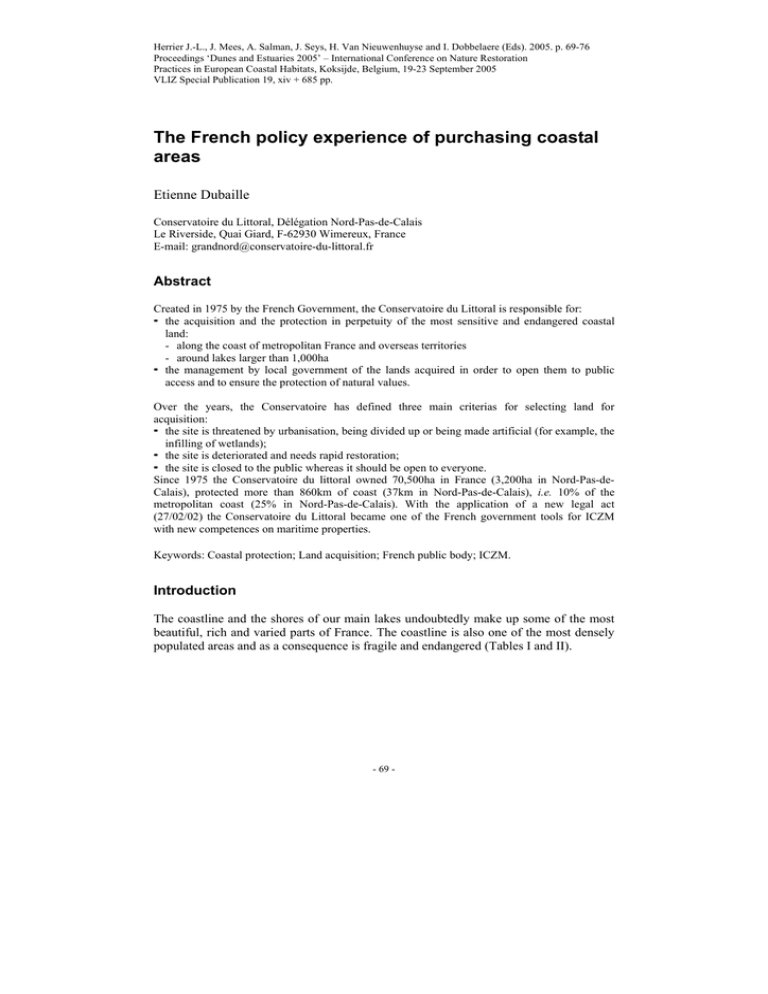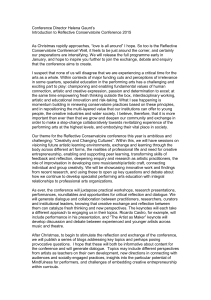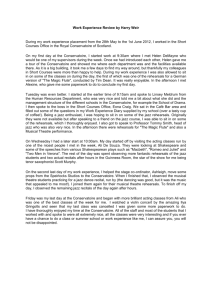Document 12903355
advertisement

Herrier J.-L., J. Mees, A. Salman, J. Seys, H. Van Nieuwenhuyse and I. Dobbelaere (Eds). 2005. p. 69-76 Proceedings ‘Dunes and Estuaries 2005’ – International Conference on Nature Restoration Practices in European Coastal Habitats, Koksijde, Belgium, 19-23 September 2005 VLIZ Special Publication 19, xiv + 685 pp. The French policy experience of purchasing coastal areas Etienne Dubaille Conservatoire du Littoral, Délégation Nord-Pas-de-Calais Le Riverside, Quai Giard, F-62930 Wimereux, France E-mail: grandnord@conservatoire-du-littoral.fr Abstract Created in 1975 by the French Government, the Conservatoire du Littoral is responsible for: the acquisition and the protection in perpetuity of the most sensitive and endangered coastal land: - along the coast of metropolitan France and overseas territories - around lakes larger than 1,000ha the management by local government of the lands acquired in order to open them to public access and to ensure the protection of natural values. Over the years, the Conservatoire has defined three main criterias for selecting land for acquisition: the site is threatened by urbanisation, being divided up or being made artificial (for example, the infilling of wetlands); the site is deteriorated and needs rapid restoration; the site is closed to the public whereas it should be open to everyone. Since 1975 the Conservatoire du littoral owned 70,500ha in France (3,200ha in Nord-Pas-deCalais), protected more than 860km of coast (37km in Nord-Pas-de-Calais), i.e. 10% of the metropolitan coast (25% in Nord-Pas-de-Calais). With the application of a new legal act (27/02/02) the Conservatoire du Littoral became one of the French government tools for ICZM with new competences on maritime properties. Keywords: Coastal protection; Land acquisition; French public body; ICZM. Introduction The coastline and the shores of our main lakes undoubtedly make up some of the most beautiful, rich and varied parts of France. The coastline is also one of the most densely populated areas and as a consequence is fragile and endangered (Tables I and II). - 69 - E. Dubaille Table I. Populated areas density (1999) Coastal communes (overseas) in France in Nord-Pas-de-Calais Coastal cantons (districts) Coastal departments France 277 hab.km-2 657 hab.km-2 186 hab.km-2 129 hab.km-2 108 hab.km-2 Table II. Population increase (1990-1999) Coastal communes (overseas) Coastal cantons (districts) France + 5.7% + 7.0% + 3.6% For this reason, the public authorities have been taking the necessary measures to protect and organize these areas. Numerous surveys have been carried out, legislation reinforced and procedures made more explicit. In 1975, the French parliament decided to enlarge these measures by creating a public organization: the ‘Conservatoire de l’Espace littoral et des Rivages lacustres’. In charge of purchasing natural sites, which are endangered (degradation and sites which may disappear in the long term), the Conservatoire is a public government agency. It has the responsibility of developing appropriate land-use policies for the protection of threatened natural areas. Its mission and types of intervention are defined in the Environment Code (articles L.322, art. R. 243). Its activities cover 22 regions, 46 departments and 1,140 coastal and lacustrine local authorities. Competence areas Metropolitan France and French overseas departments 5,200,000ha of land 10,000km of coastline (8,000km and 1,200km of coastal dunes on the metropolitan area) At the end of 2003, the Conservatoire owned 70,500ha of endangered or fragile natural beauty spots covering over 300 localities. In 2004, more than 8,000ha of coastal dunes are protected by the Conservatoire du Littoral. In this way, it guarantees the protection of 775km of coastline and inland lake shores made up of dune, marshland, mudflats, islands, woods, moors and heathland. - 70 - The French dune purchasing policy experience Breakdown of protected linear coastline Rocky coast Sand coast Humid zones Other Fig. 1. Breakdown of the protected linear coastline. Nature of protected habitats Cultures Woods Maquis heathland scrubs Dunes Humid zones Pastures Fig. 2. Nature protected habitats. The one objective is to ‘conduct a land acquisition policy to safeguard coastal zones, respect natural sites and maintain their ecological equilibrium’. In this geographical area, the Conservatoire’s mission is twofold, quantitative and qualitative. Its main priority is to acquire endangered natural sites; but it is also the safeguard for the quality of these areas as well as their ecological equilibrium. For this reason the Conservatoire can make recommendations concerning its mission to the relevant authorities. Another important public agency for dunes management is the Office national des Forêts. It is a public national organization under the supervision of the government (Ministries of Agriculture and Environment). It manages large coastal and wooded (pine - 71 - E. Dubaille forest) dunes on the Atlantic seacoast, especially in Aquitaine (SW France). Some parts of them are dedicated to biodiversity as biological reserves. A selective and reasoned intervention Within its zone of competence, the Conservatoire does not decide alone which areas should be left in their natural state. It should take into account (article R.243-2) the regulations existing as well as the Development and Urbanization Masterplans (SCOT) and Local Plans (PLU). It is up to the authorities responsible for town planning to determine which zones should be assigned to urbanization or development; the Conservatoire does not normally buy these areas, but can argue that an area should be classified as a natural zone. These considerations and the concern to use its budget as efficiently as possible, have driven the Conservatoire to define more precise selection criteria, using past experience and the general framework of the legal texts, for those situations where a policy of acquisition to reinforce the statutory intervention of the government and communes is justified. Legal framework in France to protect dunes Forestal code (L431-2) Special governmental authorization for sandy vegetation extraction and wooded destruction (L431-1) Forestry ministry can enforce dune fixations (L432-1) in the Department of Pas-de-Calais: land extraction is forbidden in dunes from the coast up to a distance of 200m inland prohibition of destruction and extraction of sandy vegetation on dunes except for the landers after special authorisation. Urbanism codes (L146-6) On the coastline, the urbanisation is forbidden in the special scientific interest areas like salt marshes, dunes, estuaries,… Environment code (L341 and so on) Areas of outstanding beauty can be protected by the law (1930’ legal Act): all new constructions are forbidden and each management is authorized by the environment administration. Broad possibilities of intervention The parliament has given the Conservatoire a whole panoply of means to acquire ownership of the land it wishes to protect, whether it concerns donations and legacies, negociated acquisitions, the right of pre-emption (substituting pre-emption by the - 72 - The French dune purchasing policy experience department) or expropriation. A public body prefers to negotiate amicably and only rarely resorts to legal proceedings. With the application of a new legal Act (27/02/2002) the government can assign maritime properties to the Conservatoire (marshes, meadows in estuary, intertidal zonation, beach along coastline,…). Land acquired by the Conservatoire receives a specific status – it becomes ‘public property of the Conservatoire’, the lands become inalienable. The Conservatoire’s public property can only be transferred by decree issued by the ‘High Court’ (Conseil d’Etat), following a recommendation by a majority of ¾ of the board of directors. An active partner for the local authorities The Conservatoire’s action is part of the government’s involvement in the effort undertaken by the local communities and Departments to preserve natural sites. The Conservatoire is compelled by parliament to closely involve the local authorities in the preparation of its acquisition program. The organization of the Conservatoire is based on the essential role played by the Conseils de Rivage (Coastal and Lakeside Councils). These councils are composed of county and regional members of the local parliament. They discuss the acquisition proposals to be submitted to the Conservatoire’s board of directors – with an equal representation of politicians and administration – which decides on the acquisition program. These councils are also consulted for each contract or partnership between the Conservatoire and local, county or regional authorities. The Conservatoire consults the communes prior to any acquisition. It also coordinates its work with the departments, which buy land with the departmental tax for environmentally sensitive areas (TDENS). The departments set up the pre-emption zones which become the framework for the Conservatoire’s interventions. With the decentralization of government, the Conservatoire is a particularly active partner of the local authorities. Its role is to collaborate with local elected people in order to develop a concerted policy of the sharing of acquisitions, financial participation and the management of the acquired sites. This overall strategy also takes into account European cooperation concerning the protection of coastal and lakeside zones. Many properties of the Conservatoire du Littoral in France participate in the application of the Habitats Directive and Birds Directive (in Nord-Pas-de-Calais 95% of the properties are incorporated in the Natura 2000 Network). Management agreements The Conservatoire does not manage the land that it owns. It signs management agreements with the local authorities whenever they are willing, either with the relevant NGOs, or with farmers. Experience has shown that the size of the sites and the expense usually lead to a partnership between the commune and the Departement as far as the management of these zones is concerned. - 73 - E. Dubaille No matter which authority is given to the management of the Conservatoire’s properties, the latter retains the right to participate in the definition and the implementation of the choice of management development. Depending on the state of the natural environment, the intervention is more or less significant, and ranges from simple conservation to restoration. To justify an intervention, the Conservatoire makes every effort to establish an ecological evaluation and a management plan for each site. The conditions of public visiting of the site, the limits of which are fixed by the ecological evaluation, are based on two principles: prohibition of all motorized traffic and camping, and the control of the numbers of people. With this in mind, the Conservatoire develops new methods of conservation, environmental restoration, landscape planning and visitors facilities. As for the existing buildings situated on the Conservatoire’s property, they are – as a rule decided by the board of directors – destroyed when they are of no real use in relation to the objectives set out and if they represent no real architectural interest. With respect to financial investments in the sites, the Conservatoire has adopted the principle that the owner is responsible for all investments essential to the protection of the natural environment, i.e. all interventions having an effect on the very nature and state of the land; however, in return, the yearly management expenses such as maintenance of infrastructure or the supervision of the area will be financed by the manager. The Conservatoire also offers technical assistance to the local authorities, a.o. in the training of the wardens. The job of these wardens is to maintain, clean and ensure the protection of the sites. They also play an educational role and provide information to the visitors. Private donations and legacies Every year, hundreds of donors send money to the Conservatoire du Littoral which assigns it to acquisitions. On several occasions, it has fund-raising campaigns to finance the acquisition and conservation of certain areas of outstanding natural beauty. This was the case in 1991 with the purchase of the Pointe du Raz. In 1992, a similar operation was launched in order to safeguard Cap Gris Nez, in the department of Pas-deCalais. In addition since October 96 it benefits from donations acquired by inheritance or capital taxes. Development of sponsorship More and more companies wish to contribute to environmental protection. Procter & Gamble France created a business foundation in June 1992 for the protection of the coastline whose sole aim is to promote the work of the Conservatoire: survey, research - 74 - The French dune purchasing policy experience on the natural environment, information campaigns, rehabilitation operations, publications. As part of this program, it financed the publishing of ‘l’Atlas des Espaces naturels du Littoral’ (Atlas of Natural Coastal Zones), produced by the Conservatoire and some general studies: Climate change and land strategy Public access, tourist pressure and management plans Forestall fire in the Mediterranean area Promoting a dynamic idea of coastal protection The Conservatoire bases its interventions on strong convictions: Only natural zones maintain a certain diversity of animal and plant communities and landscapes, which areas used for the very specific needs of human activity no longer have. The verb ‘to protect’ must not be taken as a synonym for ‘freezing’ or ‘blocking progress’. A large part of the economic production, on land or at sea, is linked to the existence of rich and varied natural surroundings, therefore the prospects for development depend on the quality of the surroundings and environment. Nature has been a constant source of inspiration for man’s development, they are complementary, not rivals. In some rare cases, however, where an unavoidable incompatibility between protection and development becomes obvious – which would have an important negative impact on the natural heritage – it is the conservation imperative which prevails. The deterioration of the landscape and natural surroundings should not be considered irreversible. What has been degraded can be repaired, even if this task is difficult, long, always expensive and often incomplete. With the help of the local authorities concerned, and thanks to public donations or company sponsorship, the Conservatoire has undertaken this policy of reconstruction and restoration of prestigious sites such as the Pointe du Raz or the Pinède de Palombaggia and tomorrow Cap Gris Nez and Cap Blanc Nez in Nord-Pas-de-Calais and Bay of Somme in Picardy which had been seriously spoiled by unsightly buildings and uncontrolled visiting. This action is significant. It is part of the development of a new type of tourism, which pays more attention to environmental quality. More than 20 million visitors come to the Conservatoire’s sites each year. Co-ordinating the interventions of the various partners The protection of the remaining natural beauty spots requires an overall policy conducted at all levels, European, national, regional, departmental and communal, accepted by all social categories, politicians, technicians, NGOs, citizens, and provided with all the necessary legal, technical and financial means: town and country planning, regulation, classification of sites, control of conveyance and acquisitions. The Conservatoire’s work, as it is decisive, must be exemplary for all the other partners involved in conservation. - 75 - E. Dubaille The necessity of creating a national heritage of natural zones protected definitively and open to all, must lead local authorities and all individuals to take more care of protecting their natural areas. In this way, nature conservation should gradually be prescribed throughout the whole country. The conservation of nature cannot be limited because it is its diversity that we must protect. References Legal acts: 10/07/75, 27/02/02, 23/02/05 - Conservatoire du Littoral’ 2003 Activities reports – Conservatoire du Littoral 2004 - ‘Construire ensemble un développement équilibré du Littoral’ – DATAR, la Documentation française 2004. - 76 -





